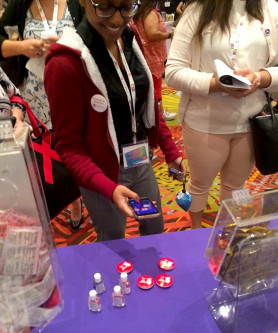Watching someone battling cancer up close and personal is difficult. It triggers memories of back in the day—when AIDS was stealing our friends and lovers while devastating communities. At the 2018 U.S. Conference on AIDS (USCA) in Orlando, Florida, my organization, Capital City AIDS Fund (CCAF), unveiled a new campaign fighting sexually transmitted infections (STIs). We are an HIV/AIDS agency but believe it would be negligent to not also address STIs. We promote health.
We still maintain no one has to get HIV/AIDS today. It’s 100 percent preventable by using a 7-cent condom. And that’s the nexus for our latest campaign. A condom prevents HIV/AIDS and also STIs.

STI buttons are a hit at USCA 2018.
At the USCA, CCAF gave away hundreds of flashing red buttons carrying the message Spread Love Not STIs. They were popular because health officials know STIs are skyrocketing. Alarmingly, many STIs, like some strains of gonorrhea, are becoming antibiotic resistant. We’re also seeing wildly high numbers of cancers caused by human papillomavirus (HPV).
Here in Sacramento, California, where I live, out of all 58 counties in the state, my county had the sixth-highest rate of chlamydia, eighth-highest rate of gonorrhea and the 10th highest rate of syphilis. All three are curable, but if left untreated they can cause long-term health problems. As for HPV, it’s rampant everywhere. And there is no cure.
Right now, I know two people fighting HPV-related cancer. My niece is 45 years old and was diagnosed with HPV-related cervical cancer three years ago. The other person is a friend recently diagnosed with HPV-related throat cancer.
HPV is the most common STI, according to the Centers for Disease Control and Prevention (CDC). In 90 percent of cases, there are no symptoms.
However, there are dozens of types of HPV and some lead to genital warts and—yes—cancer. About 45 percent of people reportedly carried types of HPV that may turn into cancer years after exposure. Planned Parenthood has renewed its recommendation for sexually active people to use condoms to prevent STIs, including HPV.
The CDC reports that almost all cervical cancer is caused by HPV. My niece has two kids in college. Her husband is 38. Grueling rounds of chemo and several surgeries have been dominating her life. She has quit work and is focusing most of her time and energy on getting well.
My other friend is in a similar situation. He has throat cancer. It used to be that throat cancers were traditionally caused by tobacco. Now, recent studies show that about 70 percent of throat cancers may be linked to HPV.
My friend Jake is nearing retirement age and has been forced to step away from his high-profile job. He just started chemo. Unfortunately, the cancer was caught too late for him to be a candidate for surgery. The hope is chemo will shrink the tumor in his neck and he gets some quality time with family.
For both Jake and my niece, their exposure to HPV goes back decades. These days, public health officials theorize that rising STI rates are related to a decrease in condom usage. During the height of the HIV/AIDS crisis, there was an increased effort and motivation to use protection. Since HIV rates have leveled and it is no longer a death sentence, condom usage has decreased.
Here in my hometown, lawmakers are recognizing we’re seeing a new crisis. STI rates are highest among people ages 15 to 24. Next year, a pilot program being launched in several college districts will offer STI testing and educational materials for students.
Many of the colleges already are distributing free condoms—partly because of the work CCAF is doing. CCAF works with all the colleges in our region. And that’s why we started a new campaign. Young people must be educated. A 7-cent condom can save a life. Spread Love Not STIs.








2 Comments
2 Comments